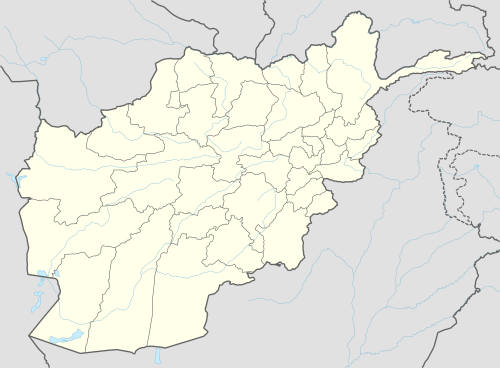Farkhar District
Farkhar District is a district of Takhar Province, Afghanistan. It is located southeast of Taloqan. It is a scenic valley surrounded with high mountains. The Khanabad River flows inside this valley. People from all around Afghanistan come to this valley for sightseeing. Around 99% of the people in Farkhar speak Persian. Farkhar's population is about 40,000 people.
Farkhar District | |
|---|---|
 Farkhar District Location of the district headquarters in Afghanistan | |
| Coordinates: 36.57°N 69.857°E | |
| Country | |
| Province | Takhār Province |
| Area | |
| • Total | 1,214 km2 (469 sq mi) |
| Population (2015)[2] | |
| • Total | 78,910 |
| • Density | 65/km2 (170/sq mi) |
| Time zone | UTC+4:30 (Afghanistan Standard Time) |
| Post code | 3752 [3] |
Huti village is one of the least populous but one of the amazing and fantastic villages of Farkhar district located on north side of the district Farkhar with an amazing view of the Farkhar river. In the summer this village looks like paradise. People from Takhar province and around Afghanistan come to this village for sightseeing and picnics. 100% people of the village speak the Persian language.
Climate
| Climate data for Farkhar | |||||||||||||
|---|---|---|---|---|---|---|---|---|---|---|---|---|---|
| Month | Jan | Feb | Mar | Apr | May | Jun | Jul | Aug | Sep | Oct | Nov | Dec | Year |
| Average high °C (°F) | 6.4 (43.5) |
8.2 (46.8) |
13.7 (56.7) |
18.9 (66.0) |
24.4 (75.9) |
31.9 (89.4) |
34.2 (93.6) |
33.5 (92.3) |
28.8 (83.8) |
22.0 (71.6) |
14.5 (58.1) |
8.4 (47.1) |
20.4 (68.7) |
| Average low °C (°F) | −3.7 (25.3) |
−1.6 (29.1) |
3.1 (37.6) |
7.7 (45.9) |
11.1 (52.0) |
15.8 (60.4) |
18.2 (64.8) |
17.1 (62.8) |
12.0 (53.6) |
7.4 (45.3) |
2.0 (35.6) |
−1.7 (28.9) |
7.3 (45.1) |
| Average precipitation mm (inches) | 43 (1.7) |
83 (3.3) |
110 (4.3) |
121 (4.8) |
74 (2.9) |
4 (0.2) |
4 (0.2) |
1 (0.0) |
1 (0.0) |
19 (0.7) |
30 (1.2) |
42 (1.7) |
532 (20.9) |
| Source: Climate data | |||||||||||||
Towns and villages
The major villages of this district are: Shaktan, Shingan, Nahr Ab, Dasht e Robat, Abi Dara, Kurani, Pire Farkhar, Shori, Dehak, Jangle Gaza, Dasht e Konj, Chashma e Garmuk, Shahre Farkhar, Kundal, Mazre Shikh, Khanaqa, Khurmab, Ardishan, Kashan, Sare Kham, Singan, Pyani, Dahne Zure, Khafdara, Sang e Atash, Khawaki, Farhangurd, Khusdeh, Darbaho, Huti, Warook, Ghashob, Yookh, Lujdeh and Mashtan.
Farkhar was a major centre of jihadist opposition to the Soviet occupation. It was the main training centre of the Afghan leader Ahmad Shah Masoud.
Origin of name
The name Farkhār is generally believed to be the Sogdian (and possibly also Khwarazmian) βṛγʾr, the equivalent of the Sanskrit word vihāra (a Buddhist monastery), which it renders in translations of Buddhist texts.[4][5] Another view is that it is not etymologically connected with vihāra but is a Persian word, originally *paru-khuvāthra "full of happiness".[6]
Although Buddhism was eventually replaced by Islam in northern Afghanistan around the 8th century,[7] as late as the 11th-century the Khwarazmian scholar al-Biruni was able to write in a discussion of Buddhists: "their monuments, the bahārs of their idols and their farkhārs, are visible on the borders of Khorasan adjacent to India".[8]
In Persian poetry
In Persian poetry, the phrase بت فرخار bot-e Farxār "buddha of a temple" or "idol from Farkhar" became proverbial for a beautiful person. One of the earliest poets to use it was Manuchehri, an 11th-century poet at the court of Mas'ud I of Ghazni, who wrote:[9]
- هنگام بهارست و جهان چون بت فرخار
- hengām-e bahār ast o jahān čun bot-e farxār
- "It is springtime and the world is like an buddha of Farkhar"
In another example the poet Khwaju (or Khaju) (d. 1352), praising a handsome Turk, writes:[10]
- شیراز ترکستان شده کان بت ز فرخار آمده
- Šīrāz Torkestān šode k'ān bot ze Farxār āmade
- "Shiraz has become Turkistan since that "buddha" came from Farkhar"
References
- "Summary of the District Development Plan: Farkhar District" (PDF). mrrd-nabdp.org. Retrieved 19 July 2020.
- "Takhar Socio-Demographic and Economic Survey 2015" (PDF). UNFPA. Retrieved 19 July 2020.
- "Farkhar, Afghanistan Postal Codes". worldpostalcode.com. Retrieved 19 July 2020.
- Buddhism in Islamic times Encyclopaedia Iranica.
- Émile Benveniste, Études sogdiennes (Wiesbaden 1979), pp. 22–23 (cited in Anna Akasoy, Charles S. F. Burnett, Ronit Yoeli-Tlalim (eds.) Islam and Tibet: Interactions Along the Musk Routes p. 68).
- V. F. Minorsky, V. V. Barthol'd, C. E. Bosworth (1982), Hudud al-'Alam 'The Regions of the World' - A Persian Geography 372 A.H ..., p. 263, citing Benveniste, Bull. Soc. Ling, 1928, xxi, 7–8.
- Buddhism i. In Pre-Islamic Times/ Encyclopaedia Iranica.
- Quoted in Anna Akasoy, Charles S. F. Burnett, Ronit Yoeli-Tlalim (eds.) Islam and Tibet: Interactions Along the Musk Routes p. 68.
- Manuchehri, "A description of spring, in praise of Khwaje Ali ibn Mohammad". (Ganjur).
- See further Domenico Ingenito (2018): "Hafez’s "Shirāzi Turk": A Geopoetical Approach" (also ), Iranian Studies, p. 17.
Further reading
- Grötzbach, Erwin F. (1999). Farḵār. Encyclopaedia Iranica online.